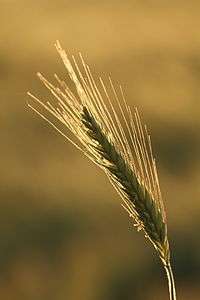Definify.com
Definition 2025
秀
秀
Translingual
Han character
秀 (radical 115 禾+2, 7 strokes, cangjie input 竹木弓竹尸 (HDNHS), four-corner 20227, composition ⿱禾乃)
Derived characters
References
- KangXi: page 849, character 3
- Dai Kanwa Jiten: character 24911
- Dae Jaweon: page 1270, character 16
- Hanyu Da Zidian: volume 4, page 2589, character 4
- Unihan data for U+79C0
Chinese
|
simp. and trad. |
秀 | |
|---|---|---|

Glyph origin
| Historical forms of the character 秀
| ||
|---|---|---|
| Bamboo and silk script | Large seal script | Small seal script |
 |
 |
 |
| Characters in the same phonetic series (秀) (Zhengzhang, 2003) | |
|---|---|
| Old Chinese | |
| 透 | *l̥ʰoːs, *hljuɡ |
| 莠 | *luʔ |
| 誘 | *luʔ |
| 蜏 | *luʔ, *slus, *lus |
| 琇 | *luʔ, *slus |
| 秀 | *slus |
| 銹 | *slus |
Pictogram (象形) : 禾 (“plant”) + 乃, resembling a fruit/an ear hanging off a plant.
Etymology
May be a causative of 褎 (OC *ljɯws, *lɯws, “growth of seedlings”). Compare Proto-Vietic *m-loh (“to blossom”) (whence Vietnamese trổ (“to burst, to open, to display”), lổ (“naked”)), and Khmer លាស់ (léas, “to grow, to blossom, to prosper”).
The meaning of “show” [noun] is a phono-semantic matching of English show.
Pronunciation
- Mandarin
- Cantonese (Jyutping): sau3
- Hakka (Sixian, PFS): siu
- Min Dong (BUC): séu
- Min Nan (POJ): siù
- Wu (Wiktionary): xieu (T2)
- Mandarin
- (Standard Chinese, Beijing)+
- Pinyin:
- Zhuyin: ㄒㄧㄡˋ
- Wade-Giles: hsiu4
- Gwoyeu Romatzyh: shiow
- IPA (key): /ɕi̯oʊ̯⁵¹/
- (Standard Chinese, Beijing)+
- Cantonese
- (Standard Cantonese, Guangzhou)+
- Jyutping: sau3
- Yale: sau
- Cantonese Pinyin: sau3
- IPA (key): /sɐu̯³³/
- (Standard Cantonese, Guangzhou)+
- Hakka
- (Sixian, incl. Miaoli and Meinong)
- Pha̍k-fa-sṳ: siu
- Hakka Romanization System: xiu
- Hagfa Pinyim: xiu4
- IPA: /ɕi̯u⁵⁵/
- (Sixian, incl. Miaoli and Meinong)
- Min Dong
- (Fuzhou)
- Bàng-uâ-cê: séu
- IPA (key): /siɛu²¹³/
- (Fuzhou)
- Min Nan
- (Hokkien)
- Pe̍h-ōe-jī: siù
- Tâi-lô: siù
- Phofsit Daibuun: siux
- IPA (Xiamen): /ɕiu²¹/
- IPA (Quanzhou): /ɕiu⁴¹/
- IPA (Zhangzhou): /ɕiu²¹/
- IPA (Taipei): /ɕiu¹¹/
- IPA (Kaohsiung): /ɕiu²¹/
- (Hokkien)
- Wu
- (Shanghainese)
- Wiktionary: xieu (T2)
- IPA (key): /ɕiɜ³⁴/
- (Shanghainese)
| Rime | |
|---|---|
| Character | 秀 |
| Reading # | 1/1 |
| Initial (聲) | 心 (16) |
| Final (韻) | 尤 (136) |
| Tone (調) | Departing (H) |
| Openness (開合) | Open |
| Division (等) | III |
| Fanqie | 息救切 |
| Reconstructions | |
| Zhengzhang Shangfang |
/sɨuH/ |
| Pan Wuyun |
/siuH/ |
| Shao Rongfen |
/siəuH/ |
| Edwin Pulleyblank |
/suwH/ |
| Li Rong |
/siuH/ |
| Wang Li |
/sĭəuH/ |
| Bernard Karlgren |
/si̯ə̯uH/ |
| Expected Mandarin Reflex |
xiù |
| Baxter-Sagart system 1.1 (2014) | |
|---|---|
| Character | 秀 |
| Reading # | 1/1 |
| Modern Beijing (Pinyin) |
xiù |
| Middle Chinese |
‹ sjuwH › |
| Old Chinese |
/*[s-l]u(ʔ)-s/ |
| English | to flower |
Notes for Old Chinese notations in the Baxter-Sagart system: * Parentheses "()" indicate uncertain presence; | |
| Zhengzhang system (2003) | |
|---|---|
| Character | 秀 |
| Reading # | 1/1 |
| No. | 13934 |
| Phonetic component |
秀 |
| Rime group |
幽 |
| Rime subdivision |
1 |
| Corresponding MC rime |
秀 |
| Old Chinese |
/*slus/ |
Definitions
秀
- †(of plants) to shoot out into ears; earing; ear
- 秀而不實 / 秀而不实 ― xiùérbùshí ― to put forth flowers but bear no fruit
- †(of plants) to bear fruit
- †(of plants) to blossom
- beautiful; elegant; graceful
- to manifest; to show; to display
- 秀出 ― xiùchū ― to show
- (especially of a person) outstanding; prominent; extraordinary
- (loanword) a show
Synonyms
Compounds
Descendants
Japanese
Kanji
- This term needs a translation to English. Please help out and add a translation, then remove the text
{{rfdef}}.
Readings
| Kanji in this term |
|---|
| 秀 |
|
しゅう Grade: S |
| on'yomi |
Proper noun
秀 (hiragana しゅう, romaji Shū)
- A male given name
Korean
Hanja
秀 • (su) (hangeul 수, revised su, McCune-Reischauer su, Yale swu)
- This term needs a translation to English. Please help out and add a translation, then remove the text
{{rfdef}}.